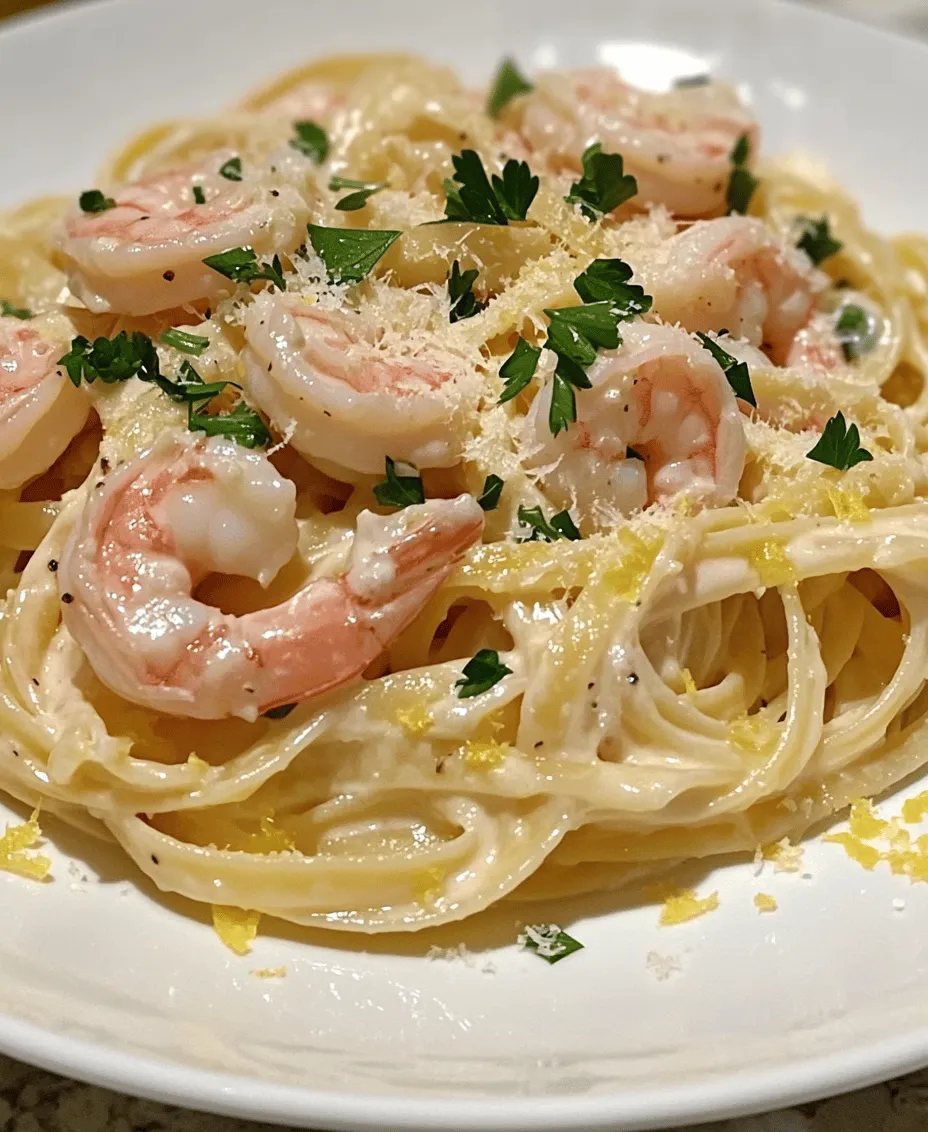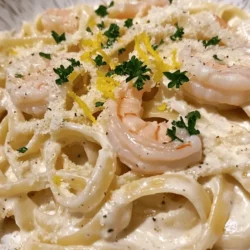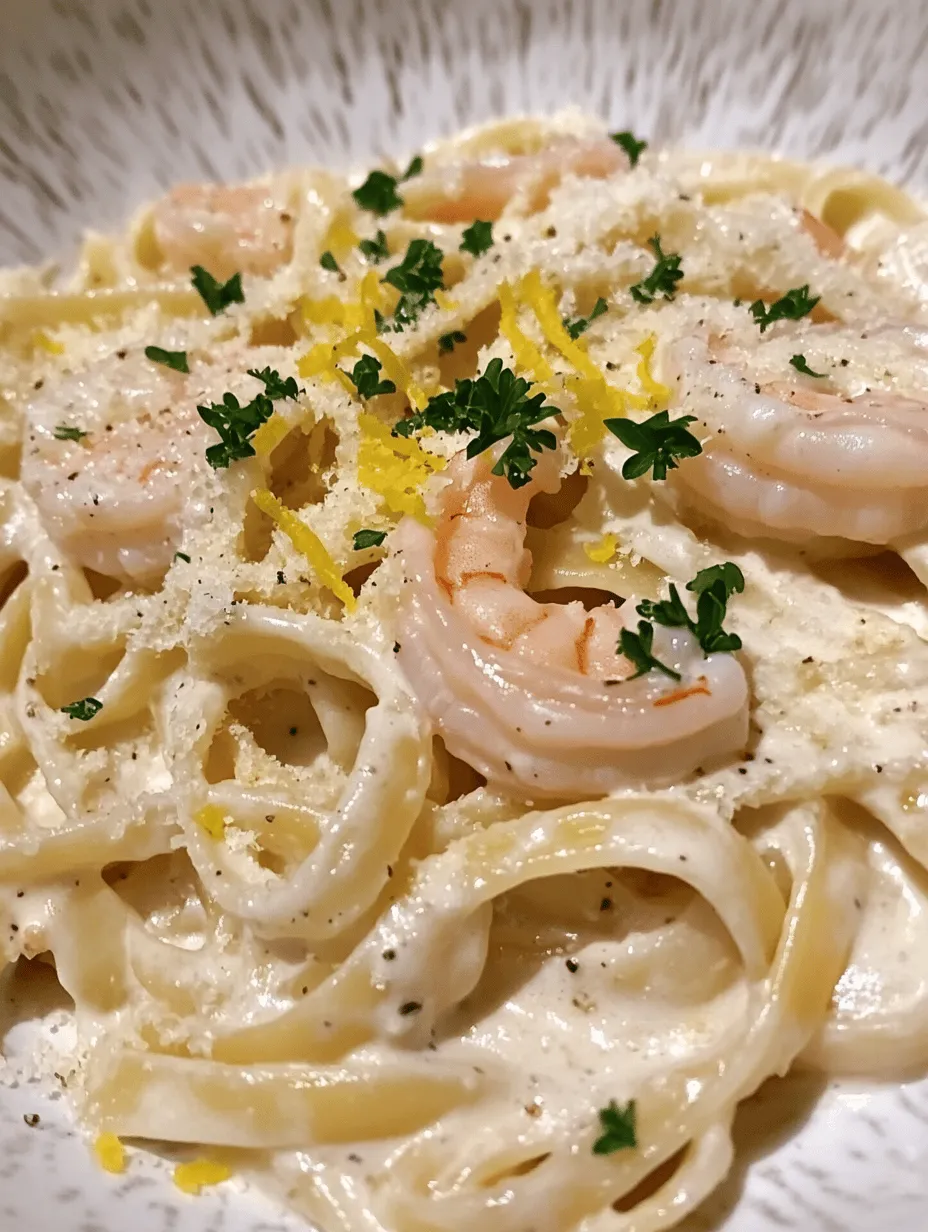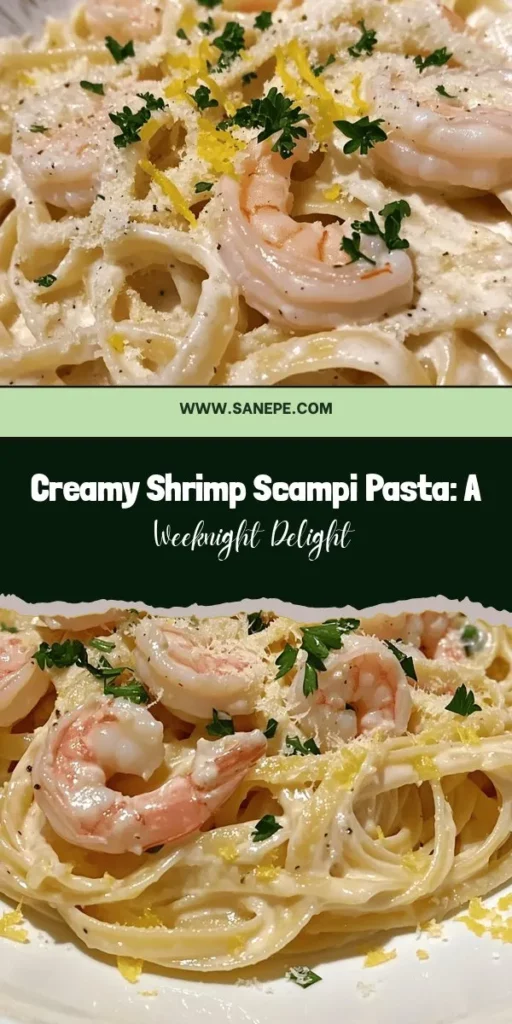Introduction
Shrimp scampi is a beloved dish that has captured the hearts and palates of seafood enthusiasts around the globe. Originating from Italian cuisine, this delightful preparation marries the sweetness of fresh shrimp with a zesty garlic and lemon sauce, making it a favorite among home cooks and restaurant-goers alike. In this article, we will explore a creative twist on the traditional recipe—Creamy Shrimp Scampi Pasta Delight. Not only does this version enhance the classic flavors with a rich and velvety cream sauce, but it also offers an effortless cooking experience that’s perfect for weeknight dinners or special occasions.
The combination of pasta with fresh seafood in a luscious sauce is not only appealing to the taste buds but also makes for a visually stunning dish that can impress any dinner guest. The creamy shrimp scampi pasta is a delightful balance of flavors and textures, where the succulent shrimp and al dente pasta come together in perfect harmony. If you’re looking to elevate your dinner game with minimal effort, this recipe is for you.
The Allure of Shrimp Scampi
Shrimp scampi traces its roots back to Italy, where it was traditionally prepared using a straightforward method that emphasized the natural flavors of the shrimp. The dish typically involves sautéing shrimp in a mixture of garlic, butter, and olive oil, often finished with a splash of white wine and a hint of lemon juice. Over time, this classic recipe has evolved, leading to various interpretations across different cuisines, particularly in the United States where creamy versions have gained popularity.
The appeal of shrimp scampi lies not only in its exquisite taste but also in its versatility. You can find numerous variations of the dish, from spicy to herbed, each bringing unique elements to the table. Despite these variations, the core ingredients remain consistent, celebrating the simplicity and freshness of seafood.
In addition to its delightful flavor, shrimp offers numerous nutritional benefits. Packed with protein and essential nutrients like omega-3 fatty acids, shrimp is a smart choice for a balanced meal. When paired with pasta, which provides carbohydrates for energy, this dish becomes a satisfying option that caters to both the palate and nutritional needs.
Ingredients Breakdown
To create the perfect Creamy Shrimp Scampi Pasta Delight, you’ll need a carefully curated selection of ingredients. Here’s a detailed breakdown:
Main Ingredients
– Fettuccine Pasta: This flat noodle is ideal for capturing the creamy sauce, but you can also substitute it with linguine or spaghetti depending on your preference.
– Shrimp: Fresh shrimp is always preferred for its superior flavor and texture. However, frozen shrimp can also be used if fresh is unavailable. Just ensure they are thawed properly before cooking.
– Butter & Olive Oil: A combination of these fats enhances the flavor profile of the dish. Butter adds richness, while olive oil brings a fruity note that complements the shrimp.
– Garlic: Fresh minced garlic is crucial for developing that classic scampi flavor. Its aromatic qualities elevate the dish significantly.
– Dry White Wine: A quality dry white wine, such as Sauvignon Blanc or Pinot Grigio, is essential for deglazing the pan and adding depth to the sauce.
– Heavy Cream: This is what transforms the dish into a creamy delight, providing a luscious texture that coats the pasta beautifully.
– Parmesan Cheese: Freshly grated Parmesan not only adds a nutty flavor but also helps thicken the sauce.
– Fresh Herbs: Parsley or basil can be used to finish the dish, adding freshness and color without overpowering the primary flavors.
– Lemon Juice & Zest: These ingredients are key for balancing the richness of the cream and butter, providing a bright and zesty contrast.
Ingredient Substitutes
For those with dietary restrictions or preferences, here are some potential substitutes:
– Pasta: Whole wheat or gluten-free pasta can be used to cater to specific dietary needs while still delivering a delicious meal.
– Shrimp: For a vegetarian option, consider using mushrooms or artichokes, which can mimic the texture of shrimp.
– Heavy Cream: For a lighter version, you can substitute half-and-half or a plant-based cream alternative.
– Wine: If you prefer not to cook with alcohol, a splash of chicken or vegetable broth with a hint of lemon can provide a similar flavor without the wine.
Fresh versus Frozen Shrimp: What to Choose?
When it comes to shrimp, freshness is key. Fresh shrimp can be found at fish markets or grocery stores and is typically sold by the pound. Look for shrimp that have a firm texture, a slight sheen, and a fresh ocean scent. If fresh shrimp is not available, frozen shrimp is a convenient alternative. Ensure you buy shrimp that are flash-frozen shortly after being caught to maintain their quality. Always thaw frozen shrimp in the refrigerator overnight or under cold running water to preserve their texture.
The Role of Butter and Olive Oil in Flavor Development
Butter and olive oil play an essential role in creating the base flavor of the dish. The combination of these two fats not only enhances the richness of the sauce but also provides a balanced flavor profile. As the butter melts and the olive oil heats up, they create a wonderful base for sautéing the garlic and shrimp, allowing the ingredients to meld and infuse their flavors into the dish.
Importance of Quality Dry White Wine in Cooking
The choice of wine can significantly impact the final flavor of your dish. A good quality dry white wine will add acidity and depth, enhancing the natural sweetness of the shrimp. When cooking, it’s important to use a wine that you would enjoy drinking, as this translates into the dish itself. Avoid cooking wines, as they often contain added salt and preservatives that can alter the flavor.
Explanation of Heavy Cream and Parmesan Cheese in Creating a Creamy Texture
Heavy cream is the star ingredient in this recipe, providing a luxurious and creamy texture that binds all the components together. When combined with freshly grated Parmesan cheese, the sauce thickens and develops a rich, cheesy flavor that elevates the entire dish. The key is to add the cream gradually, allowing it to blend seamlessly into the sauce while adjusting the consistency to your liking.
Fresh Herbs and Spices: Enhancing Flavor Without Overpowering
The addition of fresh herbs and spices is vital for bringing brightness and complexity to the dish without overwhelming it. Parsley, for instance, adds a touch of color and freshness, while a pinch of red pepper flakes can introduce a subtle heat if desired. It’s essential to use these ingredients sparingly; the goal is to enhance the existing flavors rather than mask them.
Step-by-Step Instructions
Now that we have a clear understanding of the ingredients, let’s dive into the step-by-step instructions for creating your Creamy Shrimp Scampi Pasta Delight.
Cooking the Pasta: Tips for Achieving Al Dente Perfection
1. Boil Water: In a large pot, bring salted water to a boil. The water should be seasoned well, as this is your only opportunity to flavor the pasta.
2. Add Pasta: Once the water is at a rolling boil, add the fettuccine (or your choice of pasta). Stir occasionally to prevent sticking.
3. Cooking Time: Refer to the package instructions for cooking time, typically around 8-10 minutes for fettuccine. Taste the pasta a minute or two before the suggested time to ensure it reaches an al dente texture—cooked but still firm to the bite.
4. Drain and Reserve: Once cooked, reserve about a cup of the pasta water before draining the rest. This starchy water can be added later to help adjust the sauce consistency.
Sautéing Shrimp: Techniques for Perfect Doneness and Flavor Infusion
1. Heat the Pan: In a large skillet, heat a tablespoon of olive oil and a tablespoon of butter over medium-high heat until melted and sizzling.
2. Add Garlic: Incorporate the minced garlic into the pan, sautéing for about 30 seconds until fragrant. Be careful not to let it brown, as burnt garlic can impart a bitter flavor.
3. Cook Shrimp: Add the shrimp to the skillet in a single layer. Cook for 2-3 minutes on one side until they turn pink and opaque, then flip them over and cook for an additional 1-2 minutes. Remove the shrimp from the pan and set aside.
Crafting the Sauce: Balancing Flavors with Wine, Cream, and Seasonings
1. Deglaze the Pan: In the same skillet used for the shrimp, pour in the dry white wine. Use a wooden spoon to scrape up any browned bits from the bottom of the pan, which will add depth to your sauce.
2. Simmer: Allow the wine to simmer for 2-3 minutes until it reduces slightly.
3. Add Cream and Cheese: Lower the heat and stir in the heavy cream, followed by the grated Parmesan cheese. Mix until well combined, and let it simmer gently for a few minutes to thicken.
4. Season: Taste the sauce and adjust the seasoning with salt, pepper, and lemon juice to your preference.
5. Combine: Finally, return the shrimp to the pan along with the cooked pasta, tossing everything together to coat in the creamy sauce.
With these initial steps, you’re well on your way to creating a delectable Creamy Shrimp Scampi Pasta Delight that will surely impress. Stay tuned for the next part of this article, where we’ll cover additional tips for achieving the best results and answer some common questions about this scrumptious dish.

Combining Ingredients
To create the perfect Creamy Shrimp Scampi Pasta Delight, it’s essential to combine your ingredients properly. This will ensure that each strand of pasta is evenly coated with the creamy sauce, and that the shrimp are distributed throughout the dish for a balanced flavor in every bite.
Best Practices for Ensuring Even Coating of Pasta and Shrimp:
1. Timing is Key: Make sure your pasta is cooked al dente before you start combining it with the sauce. This is crucial because the pasta will continue to cook slightly when mixed with the hot sauce.
2. Reserve Pasta Water: Before draining your pasta, reserve about half a cup of the pasta cooking water. This starchy water can be added to your sauce to adjust its consistency, allowing it to better adhere to the pasta.
3. Tossing Techniques: When adding the pasta to the skillet with the sauce, use tongs or a pasta fork to gently toss the pasta and shrimp together. This will help distribute the sauce evenly without breaking the pasta or overcooking the shrimp.
4. Use a Large Skillet: Opt for a large skillet that can comfortably hold all the ingredients without overcrowding. This allows for better mixing and ensures that the pasta and shrimp get the full flavor of the sauce.
5. Final Touches: After combining everything, give the dish a final toss over low heat for a minute or two. This will help the pasta absorb some of the flavors from the sauce and create a more cohesive dish.
Plating and Garnishing
Presentation is key when it comes to serving your Creamy Shrimp Scampi Pasta Delight. A well-plated dish not only looks appealing but also enhances the dining experience. Here are some tips for plating and garnishing:
1. Choose the Right Plate: A wide, shallow bowl works best for pasta dishes, as it allows for a generous portion while showcasing the ingredients.
2. Layering: Start by placing a mound of pasta in the center of the plate. Use tongs to twirl the pasta into a nest shape, making it visually appealing.
3. Add Shrimp Thoughtfully: Arrange the shrimp on top of the pasta so they are visible and inviting. This makes the dish look abundant and highlights the key ingredient.
4. Sauce Distribution: Drizzle any remaining sauce over the top of the pasta and shrimp. This not only adds flavor but also creates a glossy finish that makes the dish more enticing.
5. Garnish with Fresh Herbs: Finish off your presentation with a sprinkle of freshly chopped parsley or basil. This adds a pop of color and freshness to the dish.
6. Lemon Zest: A light grating of lemon zest over the top can brighten the flavors and elevate the overall presentation.
Flavor Profiles and Variations
The beauty of Creamy Shrimp Scampi Pasta lies in its complex flavor profile, which balances creamy, tangy, and spicy elements. The richness of the cream blends seamlessly with the brightness of the garlic and lemon, while a touch of heat from the red pepper flakes rounds out the dish.
Suggestions for Variations on the Classic Recipe:
1. Adding Vegetables: Incorporate fresh vegetables to enhance both the nutrition and flavor of your dish. Spinach wilts beautifully into the sauce, adding a vibrant green color and additional nutrients. Cherry tomatoes can be halved and tossed in for a sweet burst of flavor and a pop of color.
2. Experimenting with Different Herbs: While parsley is a classic garnish, consider experimenting with other herbs like fresh basil or thyme. These can introduce new flavors and aromas that complement the shrimp and creamy sauce.
3. Adjusting the Spice Level: If you enjoy a bit of heat, try using different types of chili flakes or pepper. For a more intense flavor, consider using crushed red pepper flakes, or for a milder taste, use black pepper or a pinch of paprika.
Serving Suggestions
Creamy Shrimp Scampi Pasta is versatile and pairs well with various sides and accompaniments. Here are some ideal pairings to elevate your meal:
1. Salads: A crisp green salad with a light vinaigrette pairs beautifully with this rich pasta dish. The acidity of the dressing can help cut through the creaminess of the scampi.
2. Bread: Freshly baked garlic bread or a warm baguette is perfect for soaking up any leftover sauce. This adds texture and a comforting element to the meal.
3. Wines: A chilled glass of white wine, such as Pinot Grigio or Sauvignon Blanc, complements the dish perfectly. The acidity of the wine mirrors the lemon in the pasta, enhancing the overall flavor.
4. Side Dishes: Steamed asparagus or sautéed green beans make for excellent side dishes, providing a crunchy contrast to the creamy pasta.
5. Versatility for Occasions: This dish is perfect for various occasions, from casual weeknight dinners to special celebrations. Its elegant appearance and rich flavors make it a crowd-pleaser for gatherings and dinner parties.
Nutritional Information
Understanding the nutritional content of your meal is essential, especially when trying to maintain a balanced diet. Here’s a breakdown of the nutritional content of Creamy Shrimp Scampi Pasta per serving:
– Calories: Approximately 550-600 calories
– Protein: About 25-30 grams from shrimp and pasta
– Carbohydrates: Roughly 60 grams
– Fat: Around 20-25 grams, primarily from the cream and butter
– Fiber: Approximately 3-4 grams, depending on added vegetables
While this dish is indulgent, incorporating vegetables can enhance its nutritional profile. Additionally, enjoying it as part of a balanced diet can help mitigate the impact of the higher-calorie ingredients.
Storing and Reheating Tips
If you have leftovers or want to prepare this dish ahead of time, proper storage and reheating are crucial to maintaining its flavor and texture.
1. Storing Leftovers: Allow the pasta to cool completely before transferring it to an airtight container. This will help prevent condensation, which can make the pasta mushy. Leftovers can typically be stored in the refrigerator for up to 3 days.
2. Freezing: While it’s best to enjoy this dish fresh, if you need to freeze it, portion it into freezer-safe containers. Keep in mind that the cream sauce may separate upon thawing, but it can be re-emulsified with gentle reheating.
3. Reheating Methods: To reheat, place the pasta in a skillet over low heat. Add a splash of reserved pasta water or a little extra cream to help rehydrate the sauce. Stir gently until warmed through. Alternatively, you can use a microwave, heating in short intervals and stirring frequently to ensure even heating.
Conclusion
Creamy Shrimp Scampi Pasta Delight is a dish that brings together rich flavors and satisfying textures, making it a favorite for many home cooks. Its ease of preparation ensures that anyone can create a restaurant-quality meal in their own kitchen.
We encourage you to try this recipe and make it your own by experimenting with different ingredients and variations. The joy of cooking lies not only in the act itself but in sharing meals with loved ones.
So gather your ingredients, set the table, and prepare to delight your taste buds with this creamy, savory pasta. Bon appétit!


